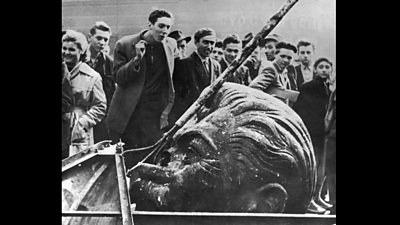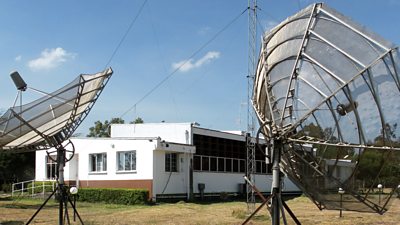The ability to listen, to sources of new information and audiences, is an essential part of broadcasting. This is as true today as it was at the outbreak of the Second World War when the ����ý’s nascent , which “tuned-in” to overseas telecommunications, was established.
Realising that this was going to be the first war in which broadcasting would play an integral part from the outset, the British Government requested that the ����ý organise for the reception, transcription and reporting of radio broadcasts from around the world.
... one thing that would make a difference between this war and the last would be that Radio would be a very important factor. And that with other communications broken down, it was bound to be important that one country should listen to what another country broadcast in order to find out what it was thinking: both in broadcasting in the public sense and radio transmissions in the more secret sense.
In order to meet this need, the ����ý convened an international workforce of linguists at its wartime evacuation centre on the Wood Norton estate at Evesham in Worcestershire. And as the number of occupied countries increased, so too did the Monitoring Service’s remit, to match the expanding global contours of the war.
One of these arrivals was the 22-year-old Hungarian-born Martin Esslin, who later became Head of Radio Drama at the ����ý. Speaking to Frank Gillard in this interview from the ����ý Oral History Collection, Esslin describes being given the specialist role of “Roving Monitor” and how a remarkable discovery while roaming the airwaves subsequently led to cracking the code of the German Army’s military communiques, providing Britain with an invaluable propaganda tool.
As this example demonstrates, the monitoring of overseas broadcasts was quickly understood by both the ����ý and the government to have an invaluable part to play in the war effort. It was not, however, an infallible means of gathering intelligence and as with all acts of translation, there was always the potential for misunderstanding.
One such moment, as Esslin explains, concerned fears of an imminent German invasion of the Iberian Peninsula.
At the height of the Second World War the was sending 30,000 words of ‘flash messages’ a day to government departments and the ����ý Newsroom. It had become a fully integrated part of the ����ý’s journalistic endeavour, and helped shape the wider knowledge context in which foreign and defence policy was formed.
At the end of hostilities, in 1945, what role was there for an institution designed for war? The answer was twofold.
First, the emergence of the Cold War as a galvanising and compelling threat offered a similar rationale to 1939, but this time with deep experience of how monitoring operations could best be used and deployed.
Secondly, its value, in an increasingly mediated world, in helping understand the communication and propaganda strategies of overseas governments and organisations was increasingly recognised.
, a future Director-General of the ����ý, joined the Monitoring Service in 1951 and here describes what made its use of open-source intelligence such an important asset during the Cold War.
As Curran notes, cooperation in this field of communications intelligence (COMINT) is indeed part of Britain’s post-war “special relationship” with America. US monitors were already stationed at the ����ý Monitoring Service when it moved to Caversham Park in Berkshire in 1943 and remained a presence there until the Monitoring Service moved to Broadcasting House in London in 2018.
This link was underpinned by an agreement reached in the Spring of 1948, between the ����ý and American monitors “for the dove-tailing of the monitoring operations of the two countries so as to avoid duplication as far as possible, and for the complete pooling of the intercepted material”. In this way, the ����ý Monitoring Service has maintained a global service.
In Cold War, as in , the speed with which live monitoring delivered vital flashes of news could have dramatic effects, for broadcasters and governments alike.
When, for example, the world found itself on the brink of nuclear war during the 1962 Cuban missile crisis, it was the ����ý Monitoring Service that reported Soviet Premier Nikita Khrushchev’s broadcast in which he ordered “the dismantlement of the weapons (on Cuba), which you describe as offensive, their packing and their return to the Soviet Union”.
Bypassing established diplomatic channels in favour of broadcasting was, in this instance, the quickest way of averting disaster: and one that relied on the capability and speed of the ����ý Monitoring Service.

It is an equally important part of the monitoring skill set to observe deviations from the norm in broadcast output. This was the case in the early hours of Wednesday 24 October 1956, the day after a massive public protest in the Hungarian capital.
During the night the protest had turned into an armed uprising, but this was behind the Iron Curtain and not immediately apparent to the outside world.
At ����ý Monitoring, however, the unscheduled appearance of “recorded chamber music” on the immediately alerted monitors to the fact that not only was something dramatic underway in the city, but that the Hungarian authorities were not in control of the situation. This information was then flashed to the ����ý Newsroom as well as the British and American governments.

Being able to assess broadcast content at this granular level, exploring the nuances of language, editing and scheduling is an act of intelligent and critical listening that identifies both the immediate significance of monitored communications as well as the wider contexts in which they are broadcast. And since its inception eighty years ago, the task of the ����ý Monitoring Service has been to examine the content of national and international media as well as the strategies deployed by the authorities and organisations that stand behind them.
Written by Dr. Alban Webb, University of Sussex.

